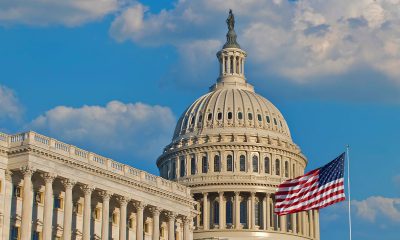Bay Area
Doctors at Roots Community Health Center Provide Straight Forward Information on COVID Risks for Oakland Families
So far in Alameda County, there were 99,681 recorded COVID-19 cases, more than 2,500 more cases than last week, and 1,291 COVID deaths.


Roots Community Health Center is presenting weekly health briefings
The Roots Community Health Center, located at 9925 International Blvd. in Oakland, is hosting an online weekly People’s Health Briefing on Facebook, offering straight-forward information about what parents, families, teachers and school staff need to know to stay safe as the Delta variant surges to extreme levels in East and West Oakland.
Presenting the health briefing this week, “A Parent’s Guide to School Reopening, were Dr. Noha Aboelata, MD, founder and CEO of the health center, and Dr. Aisha Mays, MD, the center’s director of adolescent and school-based services. The briefing is available online at www.facebook.com/rootsempowers/videos/719407845555581
Roots serves some of the people most vulnerable to catching COVID-19.
So far in Alameda County, there were 99,681 recorded COVID-19 cases, more than 2,500 more cases than last week, and 1,291 COVID deaths.
Overall, the county is doing well with vaccinations: 85.7% of those who are 12 and up have received at least one dose of the vaccine; and 72.4% are fully vaccinated, though rates vary in different neighborhoods.
However, children under 12, who are ineligible for vaccination, make up 15% of the total population.
Alameda County hospitalizations continue to rise. There are now 208 individuals in hospitals, compared to 179 last week.
Dr. Mays discussed the danger of COVID-19 for children. As of August 5, 4.3 million children in the U.S. have tested positive for COVID-19 since the pandemic began, she said. While many children have milder symptoms or no symptoms, some have gotten very sick and some have died, including infants under the age of one and children and youth with health conditions such as heart disease, asthma, sickle cell anemia and diabetes. Only 30% of children eligible to receive the vaccine have been vaccinated in the U.S.
Some parents are still trying to decide whether to send their children to in-person or distance learning, said Dr. Aboelata. “We know that no matter what we do we are going to be sacrificing something. This is about laying out the risks of each of our choices.”
With in-person schooling, parents worry their children might catch COVID, whether they might become seriously ill or might spread the infection it to someone in the home or family.
Distance learning risks include the danger of parents or caregivers losing income, increased screen time for children and doing poorly academically, as well as socially and emotionally.
A group of physicians and community leaders recently got together to express their concerns and make recommendation to the superintendent and school board of the Oakland Unified School District. See these recommendations in the Oakland Post, “Medical Professionals Call on Oakland School Leaders to Increase COVID-19 Protections.”
One central issue is whether students are vaccinated. Of course, everyone under 12 years old is unvaccinated, and no vaccine will be likely available for them later this year, according to Dr. Aboelata.
Young people who catch COVID generally do better than adults though that is not always the case.
Young people are also present the danger of infecting others. In California, 590,000 senior citizens live with school-age children. “This is more likely to be the case in households of color and can exacerbate the disparities that are already a reality of this pandemic,” she said.
Already, African Americans in Alameda County are dying at about double the rate of other residents and since April, African Americans account for the highest number of new COVID-19 cases. “This is a disparity that continues to widen,” she said.
To understand exactly how the pandemic is unfolding and to respond to it, officials must have routine testing or surveillance at each school, “which is not being implemented at any of the (district’s) school sites, ” said Aboelata.
Since there is no school site data, the best way to look at the risks is to examine community case rates. “If community transmission is high, then students and staff are more likely to come to school while infectious,” she said.
The county average of positivity case rates is 5%. There are four Oakland zip codes with extremely high positivity rates of between 9% and 12%: 94607 in West Oakland, and 94605, 94621 and 94603 in East Oakland. “94603 is the highest with a 12% positivity rate,” she said.
“We’d like to see a positivity rate of under 5% to be safe for in-person activities, “ she said. “(But) these decisions are being made on a county-wide and city-wide basis,” and ignore the great variation in case rates in different parts of the city that impact the number of cases that are potentially brought into a school.
If officials know the vaccination status of teachers and staff, the school can require an N95 mask and routine testing for unvaccinated teachers and staff in order to protect unvaccinated students, she said.
Vaccination rates in Oakland are extremely variable depending on the neighborhood but are generally 3 percentage points behind the county. About 69% of the people who are eligible are fully vaccinated in Oakland, but in some census tracts, rates are as low as 38%.
And then there is the issue of physical distancing. “We understand that it is not a requirement for OUSD to have distancing, but it is important to have the maximum distancing possible,” she said. “Distancing is most important to prevent droplet transmission. If schools “are trying to get too many people into an enclosed space … we become much more concerned about aerosol transmission, which is the main way that COVID-19 is spread,” she said.
If too many people are packed into a room, that could overwhelm the ventilation strategy, including the use of windows, doors and commercial air purifiers.
Testing is also a serious issue. “Per OUSD, all testing is optional or simply recommended,” she said. “This is most problematic when it relates to anyone with symptoms. We believe that testing should absolutely be required for anyone with symptoms that could be COVID-19.”
“If you have symptoms that could be COVID-19, you have no business setting foot on a school campus until you’ve proven that it is not COVID-19. Children who have symptoms that could be COVID-19 if possible, should take a test that shows all possible viruses that are now circulating in the region, not just COVID, she said.
Lastly, “we are concerned about how potential outbreaks will be managed,” she said. “We are concerned that the capacity for contact tracing in the county may not be sufficient for current volume let alone let alone if there’s an outbreak at a school.”
She pointed out that the Berkeley Unified School District has online data available of positive cases by date at every school. This is the kind of transparency that OUSD should consider, she said.
The Oakland Post’s coverage of local news in Alameda County is supported by the Ethnic Media Sustainability Initiative, a program created by California Black Media and Ethnic Media Services to support community newspapers across California.
Alameda County
Seth Curry Makes Impressive Debut with the Golden State Warriors
Seth looked comfortable in his new uniform, seamlessly fitting into the Warriors’ offensive and defensive system. He finished the night with an impressive 14 points, becoming one of the team’s top scorers for the game. Seth’s points came in a variety of ways – floaters, spot-up three-pointers, mid-range jumpers, and a handful of aggressive drives that kept the Oklahoma City Thunder defense on its heels.

By Y’Anad Burrell
Tuesday night was anything but ordinary for fans in San Francisco as Seth Curry made his highly anticipated debut as a new member of the Golden State Warriors. Seth didn’t disappoint, delivering a performance that not only showcased his scoring ability but also demonstrated his added value to the team.
At 35, the 12-year NBA veteran on Monday signed a contract to play with the Warriors for the rest of the season.
Seth looked comfortable in his new uniform, seamlessly fitting into the Warriors’ offensive and defensive system. He finished the night with an impressive 14 points, becoming one of the team’s top scorers for the game. Seth’s points came in a variety of ways – floaters, spot-up three-pointers, mid-range jumpers, and a handful of aggressive drives that kept the Oklahoma City Thunder defense on its heels.
One of the most memorable moments of the evening came before Seth even scored his first points. As he checked into the game, the Chase Center erupted into applause, with fans rising to their feet to give the newest Warrior a standing ovation.
The crowd’s reaction was a testament not only to Seth’s reputation as a sharpshooter but also to the excitement he brings to the Warriors. It was clear that fans quickly embraced Seth as one of their own, eager to see what he could bring to the team’s championship aspirations.
Warriors’ superstar Steph Curry – Seth’s brother – did not play due to an injury. One could only imagine what it would be like if the Curry brothers were on the court together. Magic in the making.
Seth’s debut proved to be a turning point for the Warriors. Not only did he contribute on the scoreboard, but he also brought a sense of confidence and composure to the floor.
While their loss last night, OKC 124 – GSW 112, Seth’s impact was a game-changer and there’s more yet to come. Beyond statistics, it was clear that Seth’s presence elevated the team’s performance, giving the Warriors a new force as they look to make a deep playoff run.
Activism
Oakland Post: Week of November 26 – December 2, 2025
The printed Weekly Edition of the Oakland Post: Week of November 26 – December 2, 2025

To enlarge your view of this issue, use the slider, magnifying glass icon or full page icon in the lower right corner of the browser window.
Activism
Oakland Post: Week of November 19 – 25, 2025
The printed Weekly Edition of the Oakland Post: Week of November 19 – 25, 2025

To enlarge your view of this issue, use the slider, magnifying glass icon or full page icon in the lower right corner of the browser window.
-

 Activism3 weeks ago
Activism3 weeks agoOakland Post: Week of November 12 – 18, 2025
-

 Activism4 weeks ago
Activism4 weeks agoOakland Post: Week of November 5 – 11, 2025
-

 Activism2 weeks ago
Activism2 weeks agoIN MEMORIAM: William ‘Bill’ Patterson, 94
-

 Activism3 weeks ago
Activism3 weeks agoHow Charles R. Drew University Navigated More Than $20 Million in Fed Cuts – Still Prioritizing Students and Community Health
-

 #NNPA BlackPress3 weeks ago
#NNPA BlackPress3 weeks agoThe Perfumed Hand of Hypocrisy: Trump Hosted Former Terror Suspect While America Condemns a Muslim Mayor
-

 #NNPA BlackPress3 weeks ago
#NNPA BlackPress3 weeks agoProtecting Pedophiles: The GOP’s Warped Crusade Against Its Own Lies
-

 Bay Area3 weeks ago
Bay Area3 weeks agoNo Justice in the Justice System
-

 #NNPA BlackPress4 weeks ago
#NNPA BlackPress4 weeks ago2026 Subaru Forester Wilderness Review: Everyday SUV With Extra Confidence



















































